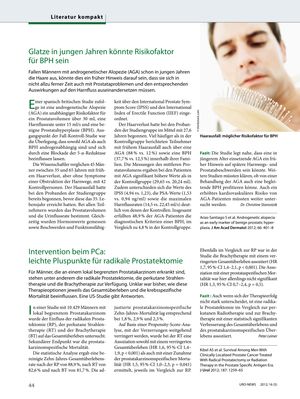TLDR Early balding may be a sign of future prostate problems.
The document suggests that early-onset androgenetic alopecia (AGA) may be an early indicator of future urinary and prostate issues, including benign prostatic hyperplasia (BPH). A Spanish-British case-control study compared 45 men aged between 35 and 65 with early hair loss but no symptoms of urinary obstruction to 42 control subjects. The study found that men with AGA had significantly higher prostate volumes (29.65 ml vs. 20.24 ml), higher International Prostate Symptom Scores (IPSS) (4.94 vs. 1.23), higher prostate-specific antigen (PSA) levels (1.53 vs. 0.94 ng/ml), and lower maximum urinary flow rates (14.5 vs. 22.45 ml/s) compared to controls. Additionally, 48.9% of AGA patients met the diagnostic criteria for BPH, compared to 4.8% in the control group. The study concludes that further research is needed to determine if treating AGA could also benefit accompanying BPH and to investigate the potential increased cardiovascular risk in AGA patients.
 28 citations
,
August 2011 in “Journal of The American Academy of Dermatology”
28 citations
,
August 2011 in “Journal of The American Academy of Dermatology” Early hair loss may indicate prostate issues.
 21 citations
,
May 2021 in “Prostate Cancer and Prostatic Diseases”
21 citations
,
May 2021 in “Prostate Cancer and Prostatic Diseases” COVID-19 might worsen symptoms and progression of benign prostatic hyperplasia, possibly due to inflammation and metabolic disturbances in the prostate gland. More research is needed to confirm this.
 28 citations
,
August 2011 in “Journal of The American Academy of Dermatology”
28 citations
,
August 2011 in “Journal of The American Academy of Dermatology” Early hair loss may indicate prostate issues.
 March 2018 in “Nepal journal of dermatology, venereology & leprology”
March 2018 in “Nepal journal of dermatology, venereology & leprology” Hair loss linked to prostate enlargement; stress and family history important factors.
 1 citations
,
December 2017 in “Journal of The European Academy of Dermatology and Venereology”
1 citations
,
December 2017 in “Journal of The European Academy of Dermatology and Venereology” Vertex baldness has higher DHT levels than frontal baldness, but testosterone and PSA levels are similar.
 35 citations
,
May 2020 in “Frontiers in Pharmacology”
35 citations
,
May 2020 in “Frontiers in Pharmacology” Different drugs for prostate-related urinary symptoms work but have various side effects, and treatment should be tailored to the individual.
 45 citations
,
January 2008 in “Drugs”
45 citations
,
January 2008 in “Drugs” Dutasteride effectively treats enlarged prostate, reduces prostate cancer risk, and promotes hair regrowth with few side effects.







